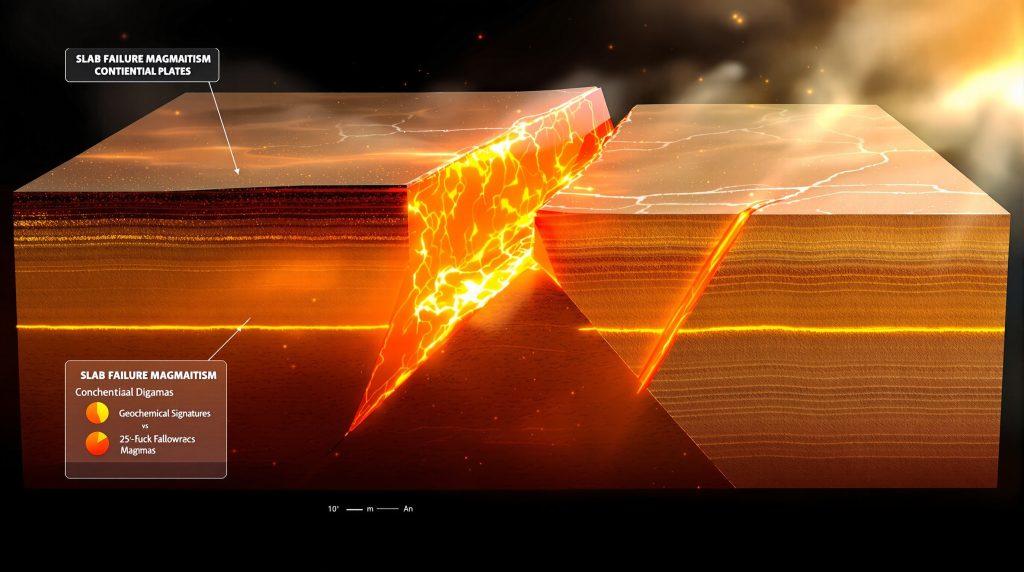What Is Slab Failure Magmatism and Why Does It Matter?
Slab failure magmatism represents a critical yet often overlooked process in Earth's crustal evolution. Unlike traditional arc magmatism, it occurs when a subducting tectonic plate tears or breaks off beneath continental margins, triggering distinctive magmatic episodes that significantly contribute to continental crust formation. This process helps resolve long-standing paradoxes in our understanding of how Earth's continental crust developed over billions of years.
The importance of slab failure magmatism lies in its ability to address what scientists call the "crustal composition paradox." Continental crust averages approximately 60% silica (andesitic to dacitic composition), yet the magmas that typically enter the crust in arc settings are primarily basaltic with only about 50% silica content (Rudnick & Gao, 2003). This discrepancy has troubled geologists for decades.
Traditional models struggle to explain how these basaltic inputs transform into the more silica-rich continental crust we observe. Converting basaltic arc magmas to upper crustal compositions would require approximately 80-90% fractional crystallization (Annen et al., 2006), producing enormous volumes of dense residual material that would need to be removed from the crust.
Key Characteristics of Slab Failure Magmas
- Post-collisional timing (typically within 1-15 million years after collision)
- Distinctive geochemical signatures different from arc magmas
- Rapid emplacement during periods of crustal extension
- Association with rapid exhumation of deep crustal rocks
- Mantle-like oxygen isotope values despite evolved radiogenic isotope compositions
Slab failure magmatism provides a direct mechanism for generating intermediate to felsic magmas from the mantle without requiring extensive fractional crystallization or crustal contamination. This makes it a compelling "missing link" in continental crust formation models.
How Does Slab Failure Differ From Traditional Arc Magmatism?
The Traditional Arc Model vs. Reality
The conventional view holds that continental crust forms primarily through arc magmatism above subduction zones. In this model, water released from the subducting plate triggers melting in the overlying mantle wedge, producing basaltic magmas that rise and differentiate within the crust.
However, this model faces a significant observational problem: modern arcs typically form in subsiding basins, not high-standing thick crust. This contradicts the traditional illustrations showing arcs as regions of thick, elevated crust.
Hamilton (1969) originally proposed that Mesozoic batholiths must exist beneath volcanic arcs, based on the observation that the only modern volcanic fields of comparable size were andesite volcanic fields. This idea became widely accepted, leading geologists to assume that Cordilleran batholiths were generated above subduction zones in high-standing regions of great crustal thickness.
Field evidence contradicts this assumption. Most active continental arcs today are characterized by sequences of rocks erupted and deposited within subsiding basins, not volcanoes sitting on high-standing thick crust.
Examples of Low-Standing Modern Arcs
- Cascades (North America): Modern and ancestral volcanoes subsided in grabens
- Alaskan Peninsula: Low-standing with partially submerged volcanoes
- Kamchatka Peninsula (Russia): Towering stratovolcanoes erupt in fault-bounded troughs near sea level
- Japanese islands: Stratovolcanoes and calderas sit near sea level
- North Island (New Zealand): Actively extending as calderas and stratovolcanoes erupt
- Central American arc: Volcanoes aligned in a linear low-standing depression
- Campanian volcanic arc (Italy): Mount Vesuvius located on the Gulf of Naples
- Hellenic arc (Mediterranean): Volcanoes form islands in the Aegean Sea
Furthermore, the stratigraphy within pendants and wall rocks of Cordilleran batholiths provides no evidence for thick crust during arc formation. Volcanic rocks are typically intercalated with shallow marine sedimentary rocks, indicating they formed at or below sea level.
The Crustal Composition Paradox
Continental crust averages 60% silica (andesitic to dacitic composition), while arc magmas entering the crust are primarily basaltic (50% silica). The traditional model requires ~86% fractional crystallization to evolve from basalt to upper crustal compositions.
This process would produce enormous volumes of dense cumulates that must be removed from the crust. The estimated ratio of cumulate to preserved magma is greater than 2:1 for bulk crust, suggesting massive volumes of material must be recycled back into the mantle through gravitational foundering.
Slab failure magmatism helps resolve this paradox by contributing silica-rich magmas directly from the mantle, reducing the amount of fractional crystallization needed to achieve observed crustal compositions.
What Triggers Slab Failure Magmatism?
The Collision-Breakoff Sequence
Slab failure magmatism follows a characteristic sequence of tectonic events:
- Continental collision causes compression and deformation
- Subducting oceanic plate detaches (breaks off) beneath the collision zone
- Asthenospheric mantle upwells through the slab gap
- Rapid melting occurs in both the broken slab and overlying mantle
- Magmas rise through subcontinental lithospheric mantle, acquiring distinctive compositions
This process was thoroughly described by Davies & von Blanckenburg (1995), who developed the model of lithosphere detachment and its connection to magmatism in collisional orogens.
When continental margins collide, the oceanic portion of the subducting plate may tear or detach due to changes in buoyancy forces. This creates a gap that allows hot asthenospheric mantle to flow upward, generating melts through decompression and heating of the surrounding lithosphere.
Timing and Tectonic Setting
Slab failure magmatism typically occurs within ~1-15 million years after major collisional events, as documented by Liégeois (1998). This relatively rapid response to collision is a key diagnostic feature that helps distinguish it from other post-collisional processes.
These magmatic episodes are commonly associated with:
- Extensional tectonics and rapid exhumation
- Formation of sedimentary basins receiving coarse plutonic debris
- Post-dating periods of crustal thickening and metamorphism
The transition from compression during collision to extension during slab breakoff creates a distinctive tectonic environment that facilitates the rapid ascent of magmas from deep sources.
What Evidence Supports the Slab Failure Model?
Case Study: Peninsula Ranges Batholith
The Peninsula Ranges Batholith of southern and Baja California provides compelling evidence for slab failure magmatism. Geological studies show that a Lower Cretaceous arc collided with a west-facing Cretaceous passive margin at approximately 100 million years ago.
Following this collision, the region experienced:
- Emplacement of voluminous post-collisional plutons (99-86 Ma)
- Rapid exhumation bringing rocks from 15-23 km depth to the surface in less than 10 million years
- Abundant coarse plutonic debris in adjacent basins, including boulder beds with clasts up to 2.5 meters in diameter
The post-collisional plutons (shown in black in geological maps) are compositionally distinct from the older arc magmas (shown in red and green). Traditional interpretations suggested these plutons formed when subduction shallowed and rising arc magmas assimilated continental crust. However, this interpretation failed to appreciate the significance of the regional deformation at 100 Ma.
Case Study: Sierra Nevada Batholith
The Sierra Nevada Batholith shows similar patterns. Arc-like magmatism occurred during the Aptian-Albian, followed by a deformational event at ~100 Ma. This was followed by emplacement of numerous plutons ranging from 98-84 Ma.
Key post-collisional plutonic complexes include:
- Sonora intrusive suite
- Tuolumne intrusive suite
- John Muir intrusive suite
- Mount Whitney intrusive suite
- Domelands intrusive suite
Geological evidence constrains the deformation to be older than 96 Ma, indicating insufficient time to thicken the crust magmatically before the post-collisional magmatism began.
The geological record shows folded volcanic rocks intercalated with marble, attesting to their shallow marine nature during deposition. These were cut by the 102 Ma granodiorite of Lake Harriet, which was subsequently deformed and metamorphosed along with the volcanic rocks. The 96 Ma Sonora Pass and Tuolumne intrusive suites post-date this deformation.
How Do Geochemical Signatures Distinguish Slab Failure Magmas?
Isotopic Evidence
One of the most compelling lines of evidence for slab failure magmatism comes from isotopic studies. Studies of oxygen isotopes in Sierra Nevada plutons by Lackey and others have revealed important patterns:
- Arc rocks (like the Stokes Mountain complex) have mantle-like δ18O values in zircon, as expected
- Surprisingly, post-100 Ma plutons (Sonora, Tuolumne, etc.) also have mantle-like δ18O zircon values, indicating a lack of crustal input
This contradicts the traditional interpretation that these plutons formed through crustal contamination of arc magmas.
When examining whole rock δ18O versus initial strontium isotope ratios, the post-collisional Sierra Crest and La Posta suites show elevated strontium values compared to the Santa Ana arc suite of the Peninsula Ranges. Importantly, Sierra Nevada peridotite xenoliths from the mantle (brought to the surface during the Miocene) have elevated strontium isotopes similar to those of the post-collisional Sierra Crest plutons.
Initial epsilon neodymium (εNd) versus initial strontium (87Sr/86Sr) ratios provide additional insights:
- Pre-100 Ma arc rocks generally plot above CHUR (Chondritic Uniform Reservoir)
- Post-100 Ma rocks plot below CHUR
This pattern is significant because arc rocks typically plot above CHUR, as illustrated by modern examples like Lassen Volcano and Crater Lake in the Cascade Volcanic Arc.
Trace Element Patterns
Post-collisional magmas show distinctive trace element patterns similar to adakites, as defined by Defant & Drummond (1990). These patterns include:
- High Sr/Y ratios
- Enrichment in light rare earth elements
- Depletion in heavy rare earth elements suggesting garnet in the source
These geochemical signatures are consistent with deep melting (>2 GPa) of metabasaltic sources, similar to what occurs in slab window environments where oceanic lithosphere is melted at high pressure.
Why Don't Slab Failure Magmas Show Crustal Contamination?
The Mantle Source Paradox
One of the most puzzling aspects of post-collisional plutons is that they have mantle-like oxygen isotope values despite radiogenic strontium and neodymium isotope ratios. This creates an apparent paradox:
- Radiogenic Sr and Nd isotopes are traditionally interpreted as evidence of crustal contamination
- Mantle-like oxygen isotopes indicate minimal crustal assimilation
The resolution to this paradox lies in the interaction of these magmas with old, enriched subcontinental lithospheric mantle rather than crustal contamination.
The Role of Subcontinental Lithospheric Mantle
During collision, continental margin lithosphere is pulled beneath the arc. Post-collisional slab failure magmas rise through this old, enriched lithospheric mantle, acquiring its isotopic signature without interacting significantly with crustal materials.
This mechanism is supported by studies of Cenozoic basalts from the Snake River Plain. Leeman et al. (2008) demonstrated that progressive incorporation of older subcontinental lithospheric mantle into the plume source as it migrated eastward could account for greater than 97% of the isotopic variability in these basalts.
Despite the lower crust beneath the Snake River Plain being old and radiogenic (with 87Sr/86Sr as high as 0.83 and εNd values ranging from -20 to -50), the post-collisional rocks have mantle-like δ18O values. This indicates they did not assimilate continental crust, and therefore their radiogenic isotopes must have been derived from the mantle.
In collision zones without old evolved cratonic lithosphere, such as the Coast Batholith of British Columbia, post-collisional magmas show the typical trace element signatures of slab failure but have more primitive neodymium values that plot above CHUR.
This pattern emerges because the subcontinental mantle typically belongs to the lower plate continental margin, not the arc. The continental margin is pulled beneath the arc during collision, isolating it from its formerly subjacent mantle. Thus, where old cratonic lithosphere is pulled beneath an arc built on young crust, adjacent arc and slab failure magmas may have very different isotopic ratios simply because they rose through different lithospheric domains.
How Does Slab Failure Magmatism Contribute to Continental Crust?
Resolving the Crustal Composition Paradox
The composition of bulk continental crust consistently plots between typical arc and slab failure magmas on element variation diagrams. This suggests continental crust forms through both processes, not just arc magmatism as traditionally believed.
Slab failure contributes significant volumes of intermediate to felsic magmas directly from the mantle, reducing the required amount of lower crustal delamination in crustal growth models. Without this contribution, the traditional arc model would require unrealistic volumes of lower crustal foundering to explain observed crustal compositions.
By providing a direct mechanism for generating silica-rich magmas from the mantle, slab failure magmatism helps bridge the gap between basaltic arc inputs and the andesitic composition of continental crust.
Global Significance Through Time
Compilation of thousands of Phanerozoic arc and post-collisional plutons shows consistent compositional differences between these two magmatic suites. Importantly, similar patterns extend back to 3.8 billion years ago with TTG (tonalite-trondhjemite-granodiorite) suites, which are compositionally similar to modern post-collisional slab failure magmas.
This suggests slab failure has been a fundamental process throughout Earth's history, contributing to continental crust formation since the early Archean. The recognition of this process helps explain why continental crust has maintained similar overall compositions for billions of years despite changes in Earth's thermal regime.
What Do Detrital Zircon Peaks Tell Us About Earth's History?
The Zircon Record and Supercontinent Cycles
Crystallization ages of >100,000 detrital zircons show distinct peaks and valleys that correlate with periods of supercontinent assembly through time. Traditional models attribute these peaks to "preservation bias" without specifying a mechanism for their formation.
The slab failure model provides a process-based explanation for these peaks:
- Supercontinent assembly involves multiple collisions
- Each collision triggers slab failure magmatism
- Collisional hinterlands with post-collisional plutons are rapidly exhumed and eroded
- This delivers abundant zircons to adjacent basins, creating the observed peaks
This interpretation suggests that detrital zircon peaks are not merely artifacts of preservation but instead reflect genuine pulses in crustal production related to supercontinent cycles.
Implications for Early Earth Tectonics
If detrital zircon peaks reflect slab failure events, this suggests some form of plate tectonics has operated since ~3.8 billion years ago. The similar compositional patterns between modern post-collisional plutons and Archean TTG suites further supports this hypothesis.
This challenges models that propose fundamentally different tectonic regimes for the early Earth and suggests crustal recycling has been an active process throughout most of Earth's history. The consistent relationship between detrital zircon peaks and periods of supercontinent assembly provides an important temporal framework for understanding Earth's tectonic evolution.
How Is Slab Failure Magmatism Generated?
Melting Mechanisms
The generation of slab failure magmas involves complex melting processes at depth:
- Initial melting of metabasaltic rocks (eclogite) in the subducted oceanic slab at depths >2 GPa
- This creates siliceous magmas with distinctive trace element patterns similar to adakites
- As melts rise through subcontinental mantle lithosphere, they interact with and trigger melting
- If lithospheric mantle is old and enriched, melts develop isotopic signatures commonly considered "crustal"
This multi-stage process explains both the distinctive trace element patterns and the apparently contradictory isotopic signatures of slab failure magmas.
Tectonic Controls
The generation of slab failure magmatism requires specific geometric configurations during collision:
- Slab detachment depth influences magma composition and volume
- Angle and rate of subduction prior to collision affect timing and intensity
- Pre-existing structure of continental margin lithosphere influences melt pathways
These factors help explain why not all collision zones produce the same volume or composition of post-collisional magmas. The variations in slab failure magmatism across different orogens reflect differences in these underlying tectonic controls.
What Are the Broader Implications of Slab Failure Magmatism?
For Continental Crust Formation
Recognizing the importance of slab failure magmatism has profound implications for our understanding of continental crust formation:
- It provides a direct mechanism for generating intermediate to felsic magmas from the mantle
- Helps explain the andesitic bulk composition of continental crust
- Reduces the required volume of lower crustal delamination in crustal growth models
- Connects crustal growth pulses to supercontinent cycles
This revised model resolves long-standing paradoxes in crustal evolution and provides a more coherent framework for interpreting Earth's geological record.
For Mineral Resources
Post-collisional settings host significant mineral deposits, making the recognition of slab failure environments important for resource exploration:
- Different metal associations compared to traditional arc-related deposits
- Potential for deeper magmatic sources tapping different metal reservoirs
- May explain certain "anomalous" magmatic-hydrothermal systems in post-collisional settings
Understanding the timing and processes of slab failure magmatism could improve exploration models and help identify new resource targets in post-collisional terranes. Furthermore, the mineral exploration importance of these settings cannot be overstated, particularly for certain commodity types.
FAQ: Common Questions About Slab Failure Magmatism
How does slab failure differ from slab rollback or slab window formation?
Slab failure specifically refers to mechanical breakoff or tearing of the subducting plate, typically during or after continental collision. Slab rollback involves backward movement of the subduction hinge without breakoff, while slab windows form when oceanic spreading ridges are subducted. All three processes can generate distinctive magmatism, but through different mechanisms and in different tectonic settings.
Can slab failure magmatism be identified in ancient terranes?
Yes, through a combination of:
- Distinctive geochemical signatures (trace elements and isotopes)
- Timing relative to deformation and metamorphic events
- Association with rapid exhumation and basin formation
- Spatial relationship to suture zones and collision belts
The recognition of these features can be crucial for understanding the mineralogy insights in ancient terranes.
Does slab failure magmatism occur in all collision zones?
Not necessarily. The process depends on factors including:
- Subduction angle and rate prior to collision
- Thickness and buoyancy of the subducting lithosphere
- Strength of the subducting slab
- Duration and intensity of the collision
- Pre-existing weaknesses in the subducting plate
Understanding these factors helps predict where along the mineral discovery curve we might expect to find evidence of slab failure magmatism.
How does slab failure magmatism relate to adakites?
Both involve melting of metabasaltic sources at high pressure, but:
- Adakites traditionally refer to melts from young, hot subducting slabs
- Slab failure magmas form when older slabs break off during collision
- Both can show similar trace element patterns (high Sr/Y, La/Yb)
- The tectonic setting and timing differ significantly
The distinction is important when interpreting drilling programs in exploration that target these different magmatic environments.
Ready to Stay Ahead of Major Mineral Discoveries?
Discovery Alert's proprietary Discovery IQ model provides instant notifications on significant ASX mineral discoveries, empowering you to identify actionable investment opportunities before the market catches on. Explore why historic discoveries can generate substantial returns by visiting Discovery Alert's dedicated discoveries page and begin your 30-day free trial today.




